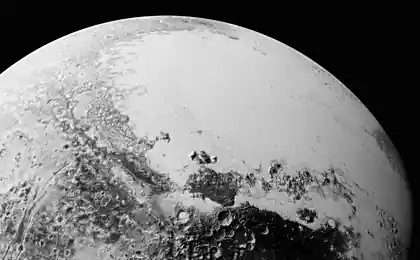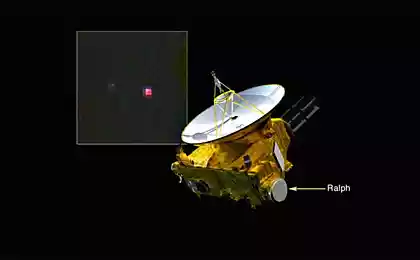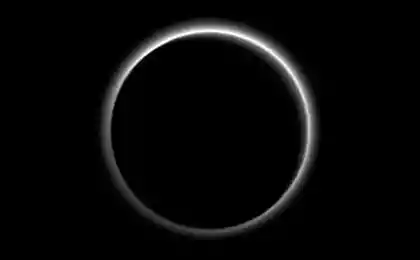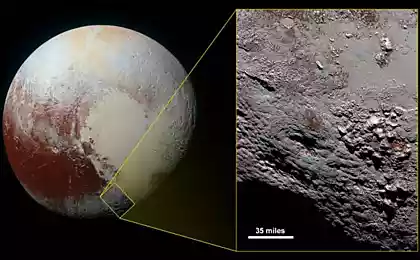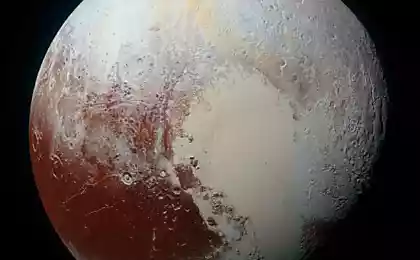2430
Interesting facts about Pluto
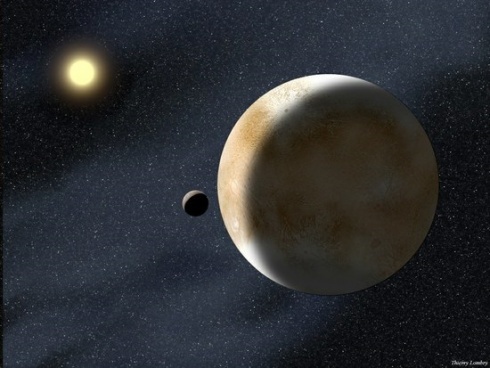
The dwarf planet Pluto is named after the Roman god of the underworld. In Roman mythology, Pluto was the son of Saturn, who with his three brothers ruled the world: Jupiter controlled the sky, Neptune was the ruler of the seas, and Pluto rules the underworld.
Pluto atmosphere consists of nitrogen with some methane and carbon monoxide.
Pluto is the only known dwarf planets, having the atmosphere. Pluto's atmosphere is unsuitable for human breathing and has a small height. When Pluto is at perihelion (closest to the sun), it becomes gaseous atmosphere. When Pluto in the aphelion (farthest from the sun), its atmosphere freezes and precipitates on the surface of the planet.
In order to make a complete revolution around the sun, Pluto requires 248 Earth years. This is the longest period of revolution around the center of our system of all the planets. The fastest of the planets in this regard is Mercury, which for a complete revolution around the sun requires 88 Earth days.
To turn once around its own axis, Pluto takes 6 days, 9 hours and 17 minutes, making it the second-slow rotation of the planet of the solar system. Most slowly rotates around its axis only Venus - for 243 Earth days. Jupiter, although it is the largest of the planets, rotates at one revolution in less than 10 Earth hours.
Pluto rotates in the direction opposite to the rotation of the Earth. This means that the sun rises in the west there, and rolled to the east. Only Venus, Uranus and Pluto rotates the opposite earth.
Since Pluto's moon Charon is only slightly smaller the planet, astronomers call them together double planet.
Sunlight reaches Pluto in five hours, and to reach the Earth's surface sunbeam takes only eight minutes.
In astrology, Pluto is associated with the beginning (revival) and destruction (death).
When Pluto entered into the category of planets in the solar system (now it belongs to the minor planets), he was considered the coldest of them. Its temperature ranges from -240 ° to -218 ° C. The average temperature is -229 ° C. The lowest temperature recorded on Earth was recorded in Antarctica and was equal to -89.2 ° C, and most of all, our planet may burn (up to 70.7 °) in the Iranian desert Lut.
A person weighing 45 kg on Earth, Pluto will weigh about 2kg 750g.
Pluto is so dark that people would be able to admire the stars from the surface all day.
Try to see Pluto from Earth - is the same as that to try to see a walnut from a distance of 50 kilometers.
Since the satellite Charon and Pluto itself revolve around each other mutually, from the surface of Pluto, Charon seems frozen in the sky motionless. Moreover, the same side always Charon Pluto and facing each other.
Pluto discovered four satellites: Charon (named after the ferryman of hell), the Knicks (after the Greek goddess of night and darkness), Hydra (on behalf of the nine-snake guarding hell) and yet unnamed satellite S / 2011 P 1, which was opened recently (in 2011).
Yet no one artificial flying object launched from Earth, Pluto did not attend. Nevertheless, the space probe New Horizons, launched in 2006, is to fly close to Pluto in 2015.
For 76 years, Pluto was considered a planet. However, when astronomers discovered that this is one of many large objects in the Kuiper belt within, Pluto in 2006 called "dwarf planet».
Pluto is the second largest dwarf planet of the solar system. Most had only Eris which is 27% more than Pluto.
Pluto is smaller than Mercury, and seven other satellites of different planets, including Ganymede, Titan, Callisto, Io, and our moon Triton.
When in 1930, Pluto was discovered, many people have offered different names for it. Options were: Hronus, Persephone, Erebus, Atlas and Prometheus. Eleven-year-Venetia Burney suggested the name Pluto. She thought it would be a good name, since the planet was so dark and was as far as the god of the underworld. May 1, 1930 the name of the planet was named officially, and she received a reward of five pounds.
Many scientists believe that if Pluto was closer to the sun, it would be classified as a planet.
Pluto is now the official name is "asteroid number 134340". He was named after the exclusion of the planets of the solar system and transfer to the rank of "dwarf planets." (Planet-dwarf stars in astronomical catalogs are designated as asteroids).
While Pluto "downgraded" to the rank of dwarf planet, many scientists are trying to classify it and several other of his colleagues to the category of planets again, as they have their own atmosphere, seasons, polar caps and their own satellites.
Sunlight on Pluto in 2000 times fainter than on Earth, and its surface the sun will seem just as a small dot in the sky.
Official symbol of Pluto are intertwined letters «P» and «L», which not only symbolize the name, but also are the initials of Percival Lowell, an American astronomer who initiated the search for the planet, which was located beyond Neptune, which led to the discovery of Neptune. One of the observatories in the US state of Arizona is named after Lowell.
Pluto the sun rises and sets about once a week.


